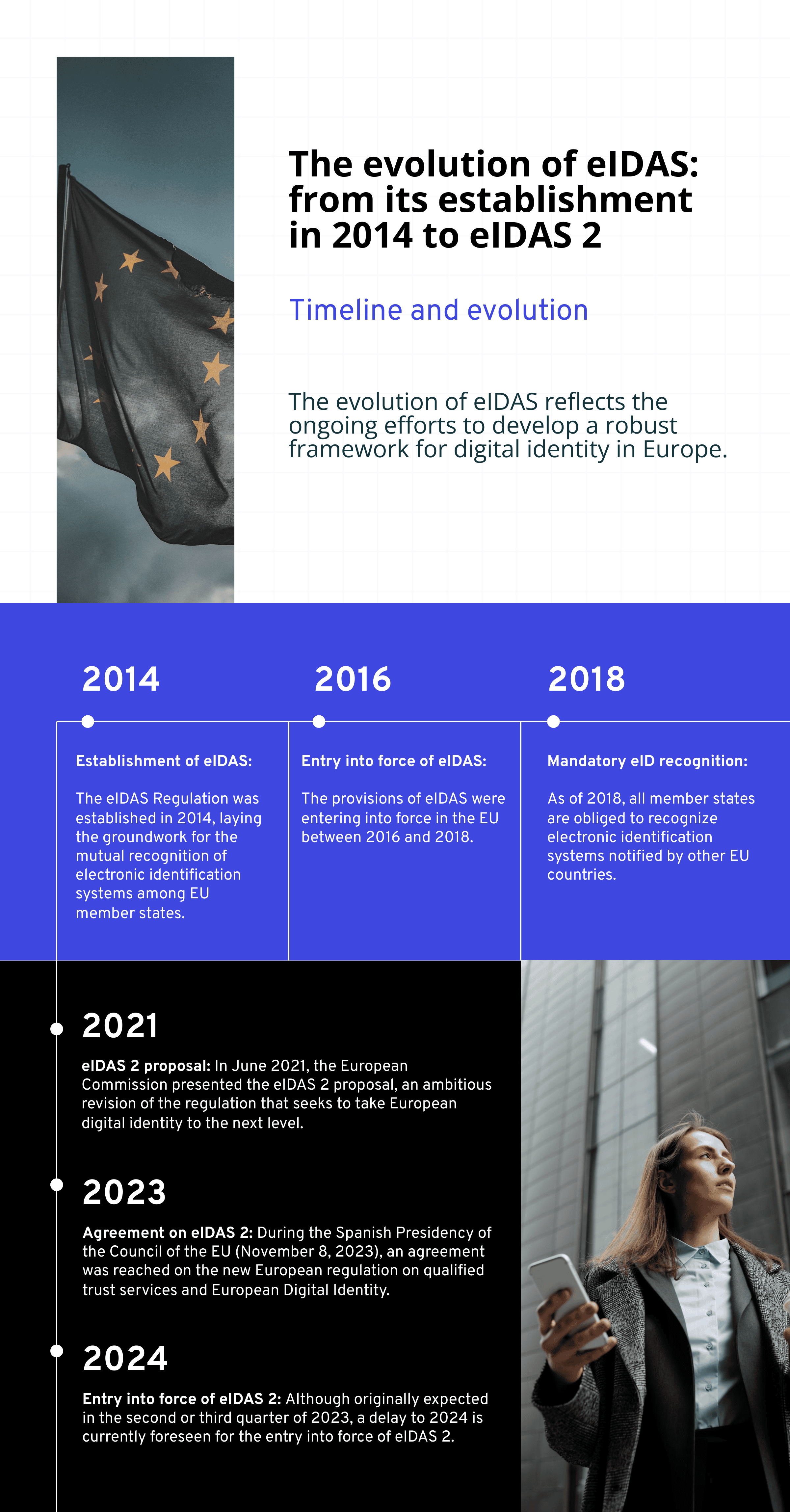Key takeaways
1. eIDAS established a legal framework for secure electronic transactions and mutual recognition of digital identities in the EU since 2014.2. The eIDAS 2 proposal aims to enhance interoperability, security, and accessibility of digital identity services across Europe.
3. eIDAS 2 will introduce innovations like European Digital Identity Wallets and new trust services.
4. Didit is an eIDAS 2 compliant decentralized identity solution offering sovereignty and privacy for individuals and businesses.
Do you know that 63% of EU citizens want a single digital identification for all online services? Digital identity has become a fundamental aspect of our lives, and in the European context, the eIDAS (electronic IDentification, Authentication and trust Services) regulation has designed a solid framework to ensure secure and reliable electronic transactions. Since its launch in 2014, eIDAS has allowed citizens and organizations in the European Union to take advantage of digitalization, protecting privacy and promoting interoperability.
However, just as technology advances, so do the challenges that legislation faces. That's why the evolution of this regulation, eIDAS 2, presents itself as a step forward that seeks to optimize everything related to digital identity across Europe.
In this post, we'll tell you all about this regulatory framework, from its origins to the current situation, and we'll analyze the challenges and opportunities faced by eIDAS 2. Additionally, we'll discuss how Didit, our sovereign and decentralized identity solution, is transforming the European digital landscape with a solution that is friendly with eIDAS legislation.
Get ready to discover how eIDAS and Didit are shaping the future of digital identity in Europe, and how you can be part of this exciting transformation.
eIDAS: The Pillar of European Digital Identity
The eIDAS regulation is a legal framework that has revolutionized digital identity in Europe. This regulatory framework, implemented in 2014, has established the foundations to ensure secure and reliable electronic transactions throughout the Union.
But what exactly is eIDAS and why is it so important? In essence, it is a set of rules and standards that regulate electronic identification and trust services in digital interactions between users, businesses, and public administrations.
Thanks to this regulation, Europeans can use their digital identity to access public and private online services in any EU country. This not only simplifies administrative procedures but also boosts the digital economy by facilitating cross-border transactions.
However, technological evolution never stops, and neither does regulation. The new proposal, known as eIDAS 2, seeks to take a step further in consolidating the European digital identity. With this, the aim is to improve the accessibility, usability, and privacy of digital identity services, as well as to promote innovation and competitiveness in the sector.
The Evolution of eIDAS: A Journey Towards European Digital Identity
In its first version, eIDAS succeeded in laying the foundations for the mutual recognition of electronic identification systems among the Member States of the European Union. This represented a significant step forward in creating a single digital market, allowing citizens and businesses to access online services securely and without friction, regardless of their country of origin.
eIDAS also established the requirements for trust services, such as electronic signatures, electronic seals, and time stamps, granting them legal validity throughout the EU. This was a crucial milestone in driving the digitalization of administrative and commercial processes, saving time and costs for both businesses and public administrations.
However, despite these achievements and as expected, the first version of eIDAS also presented some limitations. The adoption of electronic identification systems was uneven among Member States, and cross-border interoperability has not yet reached its full potential. Additionally, the rapid advancement of digital technologies has posed new challenges in terms of security, privacy, and usability. In light of this scenario, it became evident that the eIDAS Regulation needed to be updated to adapt to the demands of the present and the future. It was necessary to strengthen interoperability, improve the accessibility and ease of use of digital identity services, and address key issues such as personal data protection and fraud prevention.
Thus, in 2021, the European Commission presented the eIDAS 2 proposal, an ambitious revision of the regulation that aims to take European digital identity to the next level. With eIDAS 2, the goal is to create a more robust, inclusive, and user-centric digital identity ecosystem that fosters innovation and competitiveness in the single digital market.
eIDAS 2: The Future of Digital Identity in the European Union
The eIDAS 2 proposal represents a decisive step towards strengthening digital identity in the European Union. Addressing the shortcomings of its predecessor, eIDAS 2 seeks to improve interoperability, security, and access to digital services for citizens and organizations. To achieve this, it must address one of its primary objectives: ensuring greater interoperability between the identity systems of different Member States.
What does this mean? Any entity (person or business) will be able to use their national credentials to access online services in any EU country conveniently, easily, and securely. To this end, the legislative framework establishes a common technical and legal framework for the issuance, recognition, and acceptance of digital identities.
An Evolution Focused on Security and Convenience
Moreover, eIDAS 2 also places a strong emphasis on security. This proposal adds stricter requirements related to identity authentication and verification, as well as other measures to prevent fraud and protect users' personal data. This includes the use of advanced technologies such as biometrics, which ensure the integrity of digital identities.
Another key aspect is the pursuit of better access to digital services. eIDAS 2 aims to streamline registration and authentication processes, allowing people to access public and private services with a single click, saving time and effort for citizens.
Furthermore, eIDAS 2 also introduces important innovations, some related to identity wallets, a new concept that aims to revolutionize the way we manage our personal data and information, or with new trust services or electronic delivery.
In summary, eIDAS 2 represents the evolution of the foundations of a robust, secure, and user-centric digital identity ecosystem within the EU, with a focus on characteristics such as interoperability, security, and rapid access to services. A proposal that promises to transform the way Europeans interact with digital services, not only in their country but throughout the region.
The Approval of eIDAS 2 and Its Imminent Entry into Force
The approval of eIDAS 2 marked a historic moment for digital identity and its context. After months of negotiations and back-and-forth, on November 8, 2023, coinciding with the Spanish Presidency of the Council of the EU, an agreement was reached on the new European regulation on qualified trust services and the new European identity.
But when will the regulation come into force? It is expected that the final text will be published in the coming weeks. Once this has happened, the regulation will enter into force 20 days after its publication in the official journal. At that point, all countries that are part of the European Union will have six months to implement and/or complete the technical and organizational requirements corresponding to this new legislative framework. It will then be when the starting gun for the new era of eIDAS 2 will be fired.

Didit: The Answer to the Challenges of Digital Identity in Europe for People and Organizations
In this context, with the undoubted evolution of eIDAS and the imminent entry into force of eIDAS 2, Didit presents itself as an innovative and complete solution for managing digital identity. Our technology, centered on the user and their privacy, is designed to meet the needs of both individuals and organizations within this new European digital landscape.
Didit scrupulously complies with the requirements of eIDAS 2 and goes beyond, offering people a sovereign, secure, interoperable, and easy-to-use digital identity. With Didit, individuals have complete and absolute control over their personal information, while companies can rely on a solution that allows them to comply with regulations and offer services efficiently and securely.
For Individuals: A Sovereign and Confidential Digital Identity
Didit offers individuals a sovereign and decentralized digital identity, based on Sovereign Data Vaults technology. This means that your personal data is stored in a secure and encrypted container, ready for the next era of the Internet. Only you can decode and share your information, selecting what to reveal in each digital interaction.
With Didit, you have absolute control over your digital identity. You will access online services securely and without friction, only sharing the necessary information that you want to share. Additionally, you will be able to manage your most important documentation and assets in one place.
For Businesses: A Solution Compliant with eIDAS 2
Didit and Didit Business are solutions compliant with eIDAS 2, which means that companies that integrate our technology will be prepared for this new regulatory framework. Thanks to Didit, your business will be able to offer secure and reliable digital services, complying with the highest standards of security, interoperability, and data protection.
Our suite allows organizations to promote a complete and effective onboarding process: from authentication to payment, including identity verification (KYC). A scalable and adaptable solution to the unique needs of different businesses.


